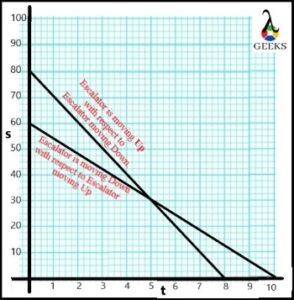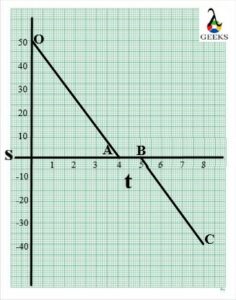The article discusses a negative constant velocity graph with solved problems and examples.
The motion is depicted when we plot its displacement or position-time graph. For an object moving opposite to another, when we plot a graph by taking a displacement or position on a y-axis and a time taken on the x-axis, it displays the negative constant velocity of an object moving in opposite.
The constant negative velocity is due to an object’s displacement or position decreasing with time. The position is the exact location of an object in a given time, whereas the displacement is the position different from one time to another.
The negative constant velocity graph reveals how an object moves in the opposite or reverse direction when no external force acts. Therefore, the graph’s slope seems to be a straight line beginning at the maximum displacement and minimum time values. It ended at a minimum displacement and maximum time values. Hence, the slope also supports us calculate the value of an object’s negative velocity.
Read more about What is Constant Negative Velocity.

Suppose the car moves on the opposite road to other vehicles. From the displacement-time graph, calculate the negative constant velocity.

Given:
From graph,
s1 = 80m
s2 = 0m
t1 = 0sec
t2 = 10 sec
To Find:
v =?
Formula:
v→ = s2-s1/t2-t1 = Δs/Δt
Solution:
The value of the negative constant velocity of moving car is calculated as,
v→ = s2-s1/t2-t1
Substituting all values,
v→= 0 -80/10-0
v→ = -8
The car moves with a negative constant velocity of -8m/s.
Read more about Constant Positive Velocity.
What is Negative Constant Velocity Graph?
The negative constant velocity graph signifies an object moving in a negative direction.
When an object moves negative or opposite, its displacement time graph displays a slightly cross and steeper straight line slope indicates the ‘negative constant velocity’. The more stepper the graph’s slope is, the faster an object moves in a negative direction with negative constant velocity.
If an object rest, then the displacement – time graph illustrated the zero motion as a horizontal straight line slope. If an object accelerates, the displacement – time graph illustrates the changing motion as a curved slope.The constant velocity conceived when zero acceleration on an object is due to no external forces being exerted, represented by displacement –time graph as straight-line slope.
Since the velocity is measured as relative motion between two objects, the constant velocity is termed ‘negative’ when two objects move opposite each other.
The perfect example of constant negative velocity is the two escalators moving in the opposite direction. i.e., one is going up, and the other is down. For the escalator going up, the people standing on the escalator going down seem to go down with constant negative velocity as its displacement decreases. Similarly, the escalator going down and the people standing on the escalator going up seem to be going with a constant negative velocity.

(credit: shutterstock)
Suppose a person chooses to go down on the escalator going up; it moves with constant negative velocity with respect to the escalator going down. At the same time, the person moves with constant positive velocity with respect to the escalator going down.
Read more about Relative Motion.
From the data, draw the displacement and time graph for both escalators going up and down with respect to each other.
| Escalator is moving Up with respect to Escalator moving Down. | |||||||||
| Displacement | 80 | 70 | 60 | 50 | 40 | 30 | 20 | 10 | 0 |
| Time | 0 | 1 | 2 | 3 | 4 | 5 | 6 | 7 | 8 |
| Escalator is moving Down with respect to Escalator moving Up | |||||||||||
| Displacement | 60 | 55 | 48 | 42 | 35 | 30 | 25 | 20 | 11 | 7 | 0 |
| Time | 0 | 1 | 2 | 3 | 4 | 5 | 6 | 7 | 8 | 9 | 10 |

Calculate the negative constant velocity for both escalators is moving opposite to each other. Comment on the result.
Given:
For escalator going Up
s1 = 80m
s2 = 0m
t1 = 0sec
t2 = 8sec
For escalator going Up
s1 = 60m
s2 = 0m
t1 = 0sec
t2 = 10sec
Solution:
The negative constant velocity of the escalator going up w.r.t. escalator going down is calculated as,
v→= s2-s1/t2-t1
Substituting all values,
v→ = 0 -80/8-0
v→ = -10 ……………(1)
The negative constant velocity of the escalator going down w.r.t. escalator going up is calculated as,
v→ =s2-s1/t2-t1
Substituting all values,
v→= 0 -60/10-0
v→ = -6……… (2)
From (1) and (2), we observe that the escalator going up w.r.t. the escalator going down is moving more rapidly with a negative constant velocity of 10m/s.
Therefore, the slope of the escalator going down w.r.t. escalator going up is more down than the escalator going up w.r.t. escalator going down.
Suppose two trains are running opposite on different tracks. After running a certain distance, both trains stop at the station for some time and start running opposite each other.
For data below, draw the negative constant velocity graph for train A running opposite to train A.
| Displacement | 50 | 35 | 25 | 15 | 0 | 0 | -15 | -25 | -40 |
| Time | 0 | 1 | 2 | 3 | 4 | 5 | 6 | 7 | 8 |

Calculate the initial and final negative constant velocity value.
Solution:
The section OA represents the train moving with negative constant velocity w.r.t. another train.
The initial negative constant velocity of train A is calculated as,
v→ = s2-s1/t2-t1
Substituting all values,
v→= 0 -50/4-0
v→ =-50/4
v→ = -12.5m/s
The horizontal line in section AB shows that both trains stop for about a second. Hence, the value of the negative constant velocity of train A zero in section AB.
The section BC represents the train again starting moving with negative constant velocity w.r.t. another train.
The final negative constant velocity of train A is calculated as,
v→ = s2-s1/t2-t1
Substituting all values,
v→ = -40/8-5
v→= -40/3
v→= -13.3m/s
Train A’s final negative constant velocity is greater than the initial negative constant velocity.
Also Read:
- Instantaneous velocity vs velocity
- Velocity of sound in air 2
- How to find velocity with horizontal and vertical components
- How to find torque from angular velocity
- How to find velocity in kinetic energy
- How to measure velocity in gas laws
- Constant velocity example
- How to find momentum from mass and velocity
- How to find velocity in m theory
- How to find velocity in gravitational waves

Hello, I’m Manish Naik completed my MSc Physics with Solid-State Electronics as a specialization. I have three years of experience in Article Writing on Physics subject. Writing, which aimed to provide accurate information to all readers, from beginners and experts.
In my leisure time, I love to spend my time in nature or visiting historical places.
Looking forward to connecting you through LinkedIn –